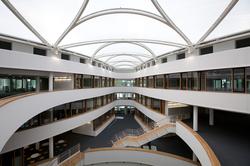New CFEL building comes to life
Researchers move into newest architectural landmark on Campus Bahrenfeld
The newest architectural landmark on DESY’s Hamburg campus has opened its doors to scientists. After more than three years of construction, the new building of the Center for Free-Electron Laser Science (CFEL) was handed over to Hamburg University.
The eye-catching facility – located across the street from the PETRA III experimental hall – comes with four thousand square meters of office space, approximately the same amount for laboratories, four hundred square meters for scientific meetings, and its own cafeteria. “The new building provides enough room for over four hundred employees,” says CFEL research coordinator Ralf Köhn. “Approximately half of them have already moved in.”
Scientists at CFEL, a scientific collaboration between DESY, the Max Planck Society, and Hamburg University, pursue research with modern light sources such as free-electron lasers. These devices produce ultra-short and ultra-intense light pulses, creating unprecedented perspectives in Physics, Biology, Chemistry, Material Science, and several other areas. CFEL groups have been working at DESY in temporary offices since early 2008.
CFEL’s new home has been designed by the Stuttgart architects hammeskrause. The building’s impressive transparent roof creates a vast open space at the center of the building with the offices arranged around it in a concentric fashion. “Open spaces have been emphasized to create synergies between the various research groups and to foster communication among scientists,” the architects state on their website.
The design of the CFEL complex also implements a variety of “green” concepts. “Plants on the building’s laboratory roofs, for instance, make up for vegetation that had to be removed during construction,” Köhn explains. “Moreover, water from one hundred metres below ground level is pumped through the office ceilings to help cool down offices in the summer and heat them in the winter.” This strategy keeps the building at a moderate temperature all year long and lowers heating costs in the wintertime.
The new facility equips scientists with twenty-one state-of-the-art laser laboratories, which are strictly vibration-cushioned and temperature-controlled. A ventilation and air-conditioning installation the size of an indoor soccer field and additional separate air-conditioning systems in the building’s basement keep the temperature on the experimentalists’ optical tables constant within half a degree.
CFEL’s laboratory space is complemented with a clean room, workshops for detector development, chemistry and biochemistry laboratories, and a spacious experimental hall for the assembly of large-scale synchrotron radiation and free-electron laser setups.
The construction costs, of approximately forty million euros, have been predominantly covered by the City of Hamburg with additional funds coming from the German federal government. To view the construction's progress from the start please go to CFEL Construction.
